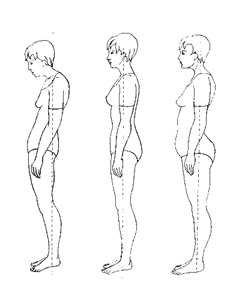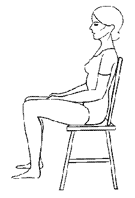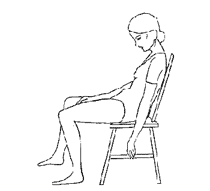Repetitive Stress
Modern man constantly abuses his body. Consider the compound effects of repetitive industrial or clerical occupations; of driving; of accommodating the body to ill-designed, mass produced furniture or equipment; of physiologically damaging footwear, such as shoes with high heels; and of restrictive undergarments; of habits such as crosslegged sitting, or standing with the weight on only one leg, etc. Just for a moment consider what the body has to cope with in a 'normal day'. Having slept on a too soft bed, the body is obliged to bend or stretch itself through the rigours of washing, shaving and dressing. Wash basins being of uniform size and bodies growing to random lengths can cause stress, even in the simple act of washing the face. The body next finds itself seated in a car, a train or a bus, and then subjected to hours of repetitive duties, either at a desk, at a workbench or in the home, etc. All this is being done on high heels or at a too low or too high desk, or in a seat too deep or too shallow, and in an habitually one-sided manner, with a slouch or stoop. It is not surprising that man has been described as 'a biped animal with backache'.
With this constant repetitive stress we can see why the degeneration of the spinal joints is well advanced by middle-age and why backache, stiff necks and general signs of 'wear and tear' are the rule rather than the exception.
When standing correctly the weight of the body is evenly distributed. A line drawn downwards from the ear should run through the centre of the ankle bone. If it falls in front of this point then the muscles of the neck and spine will be under stress in order to support the head. As the head is held forward of its correct position there occur compensating changes in the normal curves of the spine. These changes, if prolonged, produce permanent alterations which will have their effect on every aspect of body mechanics. Similar problems occur if the head is held to one side or if the pelvis is in a position of forward or backward tilting. The problem is to know how to correct these habitual postural mistakes.
It is interesting to realize that the position of the head and neck in relation to the trunk has a determining effect on the whole economy of the body. The position of the organs of the body is maintained by the fascial bands that support them. The fascia that decides the relative position of the heart, the liver or the spleen, for example, is attached directly to the fascia of the neck, which is joined to the base of the skull. Thus any permanent deviation from normal in this area will have widespread ramifications. Once again we see how the body parts interrelate.
 |
| Incorrect | Correct | Incorrect |
Two examples of poor posture together with one showing correct alignment. In the two incorrect examples it can be seen how bad body mechanics can lead to permanent alteration of muscle tone, organ displacement and stress on the spinal joints.
 |  |
Correct Sitting Position
Note: Knees higher than hips. | Wrong Sitting Position
Note: Knees lower than hips. General sagging of body. |